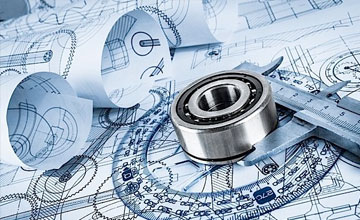
David A. Perkins
- Courses6
- Reviews19
- School: University of Dayton
- Campus:
- Department: Engineering
- Email address: Join to see
- Phone: Join to see
-
Location:
300 College Park
Dayton, OH - 45469 - Dates at University of Dayton: November 2013 - April 2020
- Office Hours: Join to see
Biography
University of Dayton - Engineering
Resume
2004
University of Dayton
Member of an interdisciplinary team focused on supporting the transition of in house production of gearbox components to outside vendors for cost reduction\n - Validate fabrication processes\n - Design of tests for dynamic and modal responses\n - Assess non-conforming parts for potential acceptance\nSupport the design and manufacture of turboprop and jet engine gear boxes\n - Perform root cause failure analysis for parts under test and in service\n - Conduct stress and force analyses\n - Redesign gearbox components for military and civil turboprop engines\n - Present analyses in oral and written formats
Rolls-Royce
University of Dayton DIMLab
Dayton
OH
Lead and assist projects relating to kinematics and mechanism design at the University of Dayton DIMLab
Lead Engineer
Instructor\n - Taught students from First Year through Senior level including courses in:\n - Design (brainstorming
conceptual/embodiment design
and prototyping)\n - Engineering mechanics\n - Programming in MATLAB\n - Modeling and analysis of mechanical engineering problems\nGraduate Research Assistant\n - Conducted research in the design of low degree of freedom mechanisms for complex tasks\n - Fabricated and analyzed prototypes\n - Presented results at conferences and in journal publications
University of Dayton
Ph.D.
Mechanical Engineering
2003
Cornerstone Research Group
Inc.
University of Dayton DIMLab
University of Dayton
Principal Investigator for Phase I and II SBIR grant: Morphing Aero-structures for a Loitering Autonomous Aircraft\n - Lead the design and testing of a morphing wing prototype while managing a team of co-op students\n - Coordinated research with contacts within the U.S. Air Force (AFRL) and other companies involved in the project\n - Mentored two University of Dayton senior design teams developing a small morphing UAV prototype\nResearch Engineer\n - Assisted research teams within the company focused on applications of proprietary shape memory and dynamic modulus composite materials for civil and defense use\n - Designed and ran experiments for testing prototypes\n - Participated on conceptual and embodiment design teams\n - Wrote grant proposals to government agencies
winning $750
000 in Phase I and II SBIR funding
Cornerstone Research Group
Inc.
University of Dayton
Teach classes on the following subjects:\n- Numerical and Computational Methods\n- Kinematics and Machine Design\n- Experimentation\n- MATLAB Programming\n- CAD and Design\n\nFaculty mentor for industry sponsored Senior level capstone design projects (mechanical
electrical and computer engineering) run through the University of Dayton Innovation Center (https://www.udayton.edu/engineering/centers/innovation_center/index.php). \n\nTechnical mentor for PhD and Masters students working with the University of Dayton DIMLab (http://academic.udayton.edu/DIMlab/)
Lecturer
Dayton
Ohio Area
1999
English
German
BSME
Mechanical Engineering
Pro Engineer
Mechanisms
Robust Design
Kinematics
Finite Element Analysis
SolidWorks
Python
ANSYS
ProEngineer
Matlab
Solidworks
Singularity-Free RPR and SPS Chains for Actuating Single Degree of Freedom Planar and Spherical Mechanisms
Andrew Murray
This paper presents a method of selecting joints relative to\na fixed and moving (coupler) frame that can be used to actuate\na single degree of freedom planar mechanism using a revoluteprismatic-\nrevolute (RPR) chain or a spherical mechanism via a\nspherical-prismatic-spherical (SPS) chain. Given a single degree\nof freedom mechanism
a moving reference frame attached\nto any link has a motion that can be described with a single parameter.\nA point relative to this moving frame is sought such\nthat it either continually increases or decreases in distance from\na point in the fixed frame over the entire motion. The mechanism\ncan then be moved by placing an actuated prismatic joint\nbetween the two points. Moreover
the singularities relative to\nthe joints in the original mechanism are not a concern and the\ndimensional synthesis can focus on creating the set of circuitdefect\nfree solutions. From this analysis
a unique fixed point is\ndetermined relative to two positions and their velocities with the\nfollowing characteristic. All points in the moving reference frame\nthat are moving away from it in the first position are approaching\nit in the second position
and vice versa.
Singularity-Free RPR and SPS Chains for Actuating Single Degree of Freedom Planar and Spherical Mechanisms
Andrew Murray
Given a single degree of freedom mechanism
a moving reference frame attached to any link has a motion that can be described with a single parameter. A point relative to this moving frame is sought such that it either continually increases or decreases in distance from a point in the fixed frame over the entire motion. These points can be used to define a revolute–prismatic–revolute (RPR) chain for a planar mechanism or a spherical–-prismatic–spherical (SPS) chain for a spherical mechanism capable of actuating the device over its entire range of motion. Moreover
the singularities relative to the joints in the original mechanism are not a concern and the dimensional synthesis can focus on creating the set of circuit-defect free solutions. From this analysis
a unique fixed point is determined in the planar case relative to two positions and their velocities with the following characteristic. All points in the moving reference frame that are moving away from it in the first position are approaching it in the second position
and vice versa. This point is as critical to the identification of singularity-free driving chains as the centrodes or the poles.
Singularity Free Revolute–Prismatic–Revolute and Spherical–Prismatic–Spherical Chains for Actuating Planar and Spherical Single Degree of Freedom Mechanisms
Ernie Havens
John Reed
Discussion of the design of a wing capable of changing airfoil shape and chord length using a morphing process. The skin is made from a proprietary shape memory polymer and various potential internal structures and actuation methods are discussed.
Morphing Wing Structures for Loitering Air Vehicles
Andrew Murray
Synthesis of Coupler-Drivers for Four Postition Planar Tasks
Venkatesh Venkataramanujam
Pierre Larochelle
Andrew Murray
Summary of an NSF research program to design low degree of freedom mechanisms capable of solving complex spatial tasks.
PODS: Novel Devices for Spatial Assembly Tasks
Brian Pelley
John Reed
Ernie Havens
Adaptive wing structures
Andrew Murray
This work presents a comparison between two actuation\nmethods for planar and spherical four-bar mechanisms. The first\nis actuation by a torque applied at either of the fixed pivots. The\nsecond actuation method uses a linear actuator connected between\nground and the coupler. For any four position task
planar\nor spherical
a one parameter set of dyads is found that may be\nused to guide the body through the four positions. Any two of\nthese dyads
when coupled
define a potential four-bar solution\nto the task. A sampling across the set of all possible mechanisms\nthat solve the four position task may be compared by analyzing\nthe internal static loads of the four-bar mechanisms. The comparison\nwas conducted to determine if coupler-driven four-bars\nhave reduced internal loading when compared to torque-driven\nmechanisms. Four position tasks were used for comparison of\nmechanisms designed for the same task
under the assumption\nthat the optimal torque-driven mechanism would have a different\nset of kinematic parameters than the optimal coupler-driven\nmechanism.
Comparison of Torque and Coupler-Driven as Solutions to Planar Four Position and Spherical Four Orientation Tasks
David
Perkins
Rolls-Royce
Possible Matching Profiles
The following profiles may or may not be the same professor:
- David Perkins
Wayne County Community College - Criminal Justice - David Perkins
University of North Carolina - Geography
Possible Matching Profiles
The following profiles may or may not be the same professor:
- David Perkins (00% Match)
Adjunct Instructor
Los Angeles Community College District - Los Angeles Community College District - Justin David Perkinson (-10% Match)
Teacher
University Of California - University Of California - David Perkins (00% Match)
Clinical Assistant Professor
Stony Brook University - [email protected] - David Perkins (00% Match)
Post Doctoral Associate
George Mason University - George Mason University





